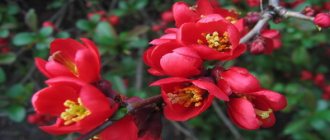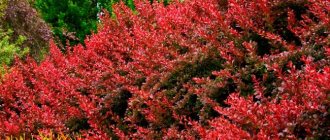Reproduction of Japanese quince is not particularly difficult even for a novice gardener, if you know how and when to do it. Therefore, in order to avoid serious mistakes, you should study in advance all possible ways of obtaining new shrub seedlings in order to choose the most optimal option. You should also familiarize yourself with the features of each method and the conditions for its implementation.
Japanese quince reproduces well by vegetative methods
Quince propagation methods
Chaenomeles, or Japanese quince, can be propagated by seeds, layering, root shoots and grafting. The first method makes it possible to obtain many new seedlings, but they do not retain the species qualities of the mother plant.
All other propagation methods are recommended to be used when it is necessary to preserve the variety of Japanese quince you like. In this case, the plants completely reproduce the characteristics of the mother bush. But the disadvantage of these propagation methods is that they only produce a limited number of seedlings.
Important! Plants grown from seeds have increased resistance to adverse external factors and are suitable for rootstock.
Is it possible to take quince cuttings?
To obtain new planting material for Japanese quince, you can also use the cutting method. However, the survival rate of seedlings is 30-50%, which is the norm for this crop.
For some decorative grafted varieties of Japanese quince, cuttings may be the only way to obtain seedlings that fully retain their species properties.
Is it possible to divide the rhizome
Dividing the bush as a method of propagation is unacceptable for this crop, since the resulting parts do not take root after transplantation. An alternative may be to plant the basal shoots that the plant produces annually at the base.
How to propagate Japanese quince from cuttings
Propagation by cuttings of Japanese quince is possible in the summer, namely in early June. During this period, many new young shoots are formed on the bush. Cuttings should be cut in dry, cool weather.
What tools and materials will be needed
To cut Japanese quince, you need to use a sharp knife, which will ensure even, rather than torn, cuts. Before carrying out the procedure, the instrument should be disinfected with an alcohol-containing liquid or scalded with boiling water. This will eliminate the possibility of infection getting into open wounds.
You should also prepare a substrate consisting of peat and sand in a ratio of 1:3. And for planting cuttings, use wide containers 15-20 cm high. If they are rooted in water, you need to prepare tall transparent glasses.
It is not recommended to cut Japanese quince at temperatures above +20 degrees
How to take cuttings from Japanese quince
For propagation, you need to use well-developed young shoots with a diameter of 0.5-0.7 cm. They must be divided into parts, each of which must have two internodes. The bottom cut should be made obliquely 1 cm below the first pair of leaves. And the top, flat one is 1.5 cm higher than the internode.
Important! Good survival results are shown by parts of shoots cut with a “heel”, that is, a small piece of last year’s wood up to 1 cm in size.
How to root Japanese quince cuttings
To increase the percentage of rooting of cuttings, you need to soak them in a Heteroauxin solution for at least 2 hours before planting them in the substrate.
For planting, fill prepared wide containers with sand and peat substrate. Then the soil needs to be well moistened and the surface leveled. After this, plant the cuttings at an angle and slightly compact the soil at their base.
Japanese quince cuttings take root in the ground in 30-40 days
At the end of the planting procedure, cover with a transparent film and place the container in a bright place with a temperature of +23 degrees. Further care: regularly ventilate the cuttings, watering as the top layer of soil in the container dries. As soon as young leaves begin to grow, the cover can be removed, as this sign indicates the appearance of roots. You can transplant the seedlings to a permanent place in early autumn, when they are strong enough.
Japanese quince cuttings can also be rooted in water. But for the procedure to be successful, it is necessary to eliminate as much as possible the possibility of shoot rotting.
To do this you need:
- do not change, but only add water as it evaporates;
- place the cuttings in a spacious container so that they do not touch;
- provide diffused lighting, keeping the temperature within +23-25 degrees.
When roots grow in water up to 5 cm long, the cuttings need to be transplanted into pots. And they can only be moved to a permanent place in the fall or spring.
The lower cut of the cutting is made oblique to increase the rooting area
Chaenomeles varieties
"Ellie Mossel" - fiery red flowers, repeats flowering in summer.
"Nikolin" - scarlet bloom of double flowers.
“Crimson and Gold” is one of the most valuable varieties of magnificent quince with dark scarlet flowers and branched shoots.
"Crimson and Gold"
'Red Scarlet' with simple red flowers.
"Pink Lady" with large dark pink semi-double flowers.
Snow-white “Jet Trail”, a characteristic feature of which is arched, smooth, thornless, creeping shoots.
Valuable variety “Geisha Girl” with double, very large apricot-colored flowers.
"Geisha Girl"
"Clementine" - orange flowers, very large, usually solitary.
A popular and spectacular quince variety is the magnificent “Scarlet Storm” with large double bright red flowers, similar to roses.
"Sido" is a low bush up to 1 meter in height with a width of 2 m, shoots without thorns, characterized by abundant orange flowering and large fruits.
“Red Joy” - reaches 0.5-0.8 m in height, the shoots are quite thin with sharp thorns, the leaves are small, dark green and shiny. The flowers are crimson, double.
“Toyo-Nishiki” is perhaps the most unusual variety of Chaenomeles - on one bush you can see flowers in three different shades: white, pink and even red.
Variety "Cameo" with magnificent double flowers of cream with a pink tint.
"Cameo"
How to propagate Japanese quince by seeds
For planting, you need to use seeds collected from ripened fruits in the fall. Before carrying out the procedure, they should be separated from the pulp. Then it is necessary to rinse with water and dry slightly until characteristic flowability appears. For successful germination of quince seeds, stratification is required, which involves exposure to low temperatures.
Important! Japanese quince seeds remain viable for two years.
Therefore, planting can be done in the fall directly into open ground. In this case, stratification will take place in winter. To do this, you need to dig up the area. Level the surface and plant the seeds in moist soil to a depth of 2 cm. With the arrival of spring warmth, they will germinate.
It is possible to propagate quince by seeds and at home. In this case, planting is recommended in December. To do this, you need to fill wide containers with sand and peat substrate, not filling 1 cm to the edges. After this, spread the seeds at a distance of 2 cm. And then sprinkle them on top with a layer of substrate 0.5-1 cm thick. When finished, compact the surface of the soil and moisten it from a spray bottle.
To successfully propagate Japanese quince with seeds at home, after planting, you need to cover the container with a transparent film and place it in the lower compartment of the refrigerator for two months for stratification. After the waiting period has expired, the container should be moved to a bright window sill and the temperature should be maintained within +23 degrees. When the seeds germinate and the sprouts become stronger, the film can be removed. Further care: watering as needed, transplanting into separate pots when four true leaves appear.
Seedlings grown from seeds must be kept at home for a year so that they can fully grow stronger. They can be planted in a permanent place in open ground only at the beginning of next summer.
The germination rate of quince seeds is 85%
Important! When propagated by seed, the shrub begins to bear fruit at 6-7 years.
Features of bush transplantation
Sometimes it becomes necessary to move a plant from its “home” place. Japanese quince develops a powerful rhizome over time. Moving an adult plant will be successful only if the root system is completely intact, but this is quite difficult to do. The beginning or middle of September is suitable for replanting work, so that the bush has time to take root before the onset of cold weather.
Important! Chaenomeles tolerates replanting extremely poorly - it takes root with great difficulty, and the yield of the bush decreases sharply.
The sequence of actions is as follows:
- Prepare a hole corresponding to the diameter of the root system.
- Pour soil mixed with fertilizer into the hole.
- Lower the bush, carefully and carefully straightening the roots.
- Cover the hole with soil mixture.
- Compact the soil around the trunk and water thoroughly.
If the shrub reproduces independently and grows chaotically, then it forms a hedge with small, more decorative than edible, fruits. It is recommended to control young plantings, maintaining a distance between plants of 1–1.5 m.
Japanese quince is a real long-liver, capable of decorating a plot for at least half a century. It remains decorative all year round, and its fruits are healthy and tasty, so you just have to decide on a method and independently propagate this universal plant in your garden.
How to propagate quince by layering
Common quince can also be propagated by layering. This is considered the easiest way to obtain new plant seedlings. To do this, it is necessary to bend the young side shoots to the ground in early spring and bury them 8 cm into the soil, leaving only the top. To prevent the branches from bending, they need to be secured with staples.
Throughout the season, it is necessary to control soil moisture. Also, the cuttings should be periodically fed with organic matter, which stimulates root growth. It is recommended to separate the young seedling from the mother bush only next spring. Then he will be able to get stronger before winter.
Seedlings obtained from layerings have a 100% survival rate
Planting Chaenomeles
A plant with an open root system is planted at the end of March or in mid-autumn so that the bush has time to adapt to new conditions and take root well. Container bushes can be planted with a clod of soil at any time. Two to three year old specimens take root best.
Make sure that when planting, the root collar does not go deep into the soil, but remains at ground level. If you plant several varieties at once, the distance between them will depend on the maximum growth of the bush. Large specimens are usually planted at a distance of 1.5 meters from each other.
During planting, immediately add nutrients to the soil: two parts of peat, 100 g of superphosphate, 400 g of ash, part of sand and a couple of kilograms of humus. Young seedlings require regular watering at first. In dry summers, it is recommended to mulch the soil, as mulch prevents moisture evaporation and controls the growth of weeds.
Read on the topic: Mulching function and types of mulches
Reproduction by young root shoots
Reproduction of the Japanese quince shrub is also possible by root shoots. To do this, it is necessary to select shoots of 10-15 cm and a diameter of at least 1 cm. They must be separated with a shovel along with the roots from the mother plant and immediately planted in a permanent place.
For successful establishment, it is necessary to control the level of soil moisture, since even slight drying out of the roots during the adaptation period can lead to the death of seedlings. Throughout the season, the plant should be properly cared for. It involves loosening the soil after each moistening to maintain soil aeration. Weeds should also be removed promptly. And during hot periods, it is necessary to lay 3 cm thick straw mulch at the base of the young bush. This helps prevent excessive evaporation of moisture.
Reproduction by grafting
Many ornamental varieties of Japanese quince are propagated by grafting onto wild seedlings.
This propagation method should be used in the spring. Experienced gardeners recommend using budding, that is, grafting with the eye. Cuttings of varietal chaenomeles should be harvested in July or August during the period of active sap flow. And then store in a damp cloth in the refrigerator.
To graft, it is necessary to cut off a bud from the middle part of a varietal shoot with a sharp knife with a shield. Then make a T-shaped cut on the rootstock shoot and bend the edges of the bark. After this, push the kidney shield under it. Return the bark to its place, cover the graft with garden varnish. If everything went well, the kidney will begin to develop in a month.
All incisions during vaccination must be made with a sterile instrument.
Important! Grafting makes it possible to obtain a seedling with increased resistance to adverse external factors and excellent taste of the fruit.
Features of planting and care in various regions, including the Moscow region, Siberia
According to gardeners, chaenomeles bushes are able to withstand frosts down to 30 o C. This makes it possible to grow Japanese quince in places with a harsh climate.
To prevent shoots from freezing, either cover the plants or bend the branches in advance so that the bush is then completely covered with snow. To do this, pin the branches to the ground with wire clamps or simply tilt the shoots and place a load on top. When planting, it is important to choose illuminated areas on the south side of the house or southern slopes if the site is on a hill. Chaenomeles grows on both clay and light soils
Fertilizing and watering help increase the size and ripening of fruits.
For summer residents who prefer to spend weekends at their dacha without bothering themselves with gardening work, it is enough to plant the bush in a sunny place, prune it in early spring, and water it periodically. Some people water 2-3 times throughout the season in the absence of rain.
In short summer conditions, the fruits are collected unripe. They ripen when lying around.
The climate in the Moscow region is quite mild, and in summer there are no problems when growing chaenomeles. Water during prolonged drought, but this is very rare for the Moscow region
It is important to take care of covering the bushes so that the flower buds do not suffer in winters with little snow. If you weren’t able to get to the site for one reason or another, don’t be upset.
The bush is easily restored. You need to cut off the frozen branches in the spring, and chaenomeles will delight you with flowers near the trunk.
In Western Siberia, the weather is characterized by sudden temperature changes. From May to July it is often hot, so the Japanese quince is watered so that the ovary does not fall off. Watering is usually carried out in the first ten days of June and July. If there is no rain, you can repeat watering in August.











